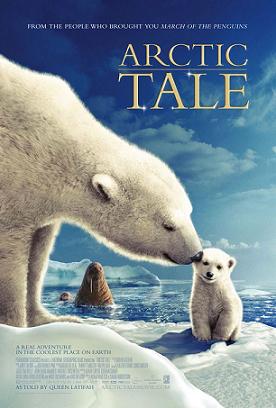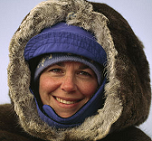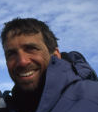
Main Page
Interviews Menu
Alphabetical Menu
Chronological Menu



Sarah Robertson and Adam Ravetch co-direct Arctic Tale, a documentary about a walrus, Seela, and a polar bear, Nanu, as they journey from birth to adolescence to maturity and parenthood in the frozen Arctic wilderness. Queen Latifah narrates. This marks the first feature documentary that Sarah Robertson and her husband, Adam Ravetch, have directed. Adam Ravetch also serves as the cinematographer. Their past footage of nature in the Arctic has aired on PBS. I had the privilege to interview them together. Paramount Vantage will release Arctic Tale on July 25th, 2007 at the Angelika Film Center and AMC/Loews Lincoln Square before opening nationwide on August 17th, 2007. NNYC MOVIE GURU: Where did you live while filming? AR: There are several communities in the Canadian Arctic. These are Inuit people. The villages have 800 people. There’s one with 250 people and a couple that have 2,000. There, we gather all of our supplies and work with the Inuks, the Inuit people, and sometimes we would go out by dog-team, snow machine and sled. We lived out on the ice. What we found over the years is that if you really live side-by-side with the animals and get them used to you, that’s when you get the most remarkable behaviors. NYC MOVIE GURU: What was it like getting to the filming location? SR: In the Canadian Arctic, there are planes that fly into every single northern Canadian community. Once you get into these communities, then we hire Inuit people and their equipment. From there, we go out into the land. Sometimes we’d have to go hundred of miles into the land where the animals are and we make our camps out there. AR: Sometimes it’s more difficult than that. I’ve worked on ice sheets when are really just a frozen ocean. They’re too thin to get out on by snow machinery or even a dog team. We had the land out on the edge, where the frozen ocean meets the open water, with Cessnas with skis on the bottom of it to land on. Those situations are sometimes a little bit more difficult because you have to make sure that it’s thick enough for you to land on it. You have to deal with the ice that’s constantly breaking off into the open ocean. Every situation is different and it’s a really difficult place to work. NYC MOVIE GURU: Did you encounter any particular danger while filming? AR: Many times we had awoken at night with something pushing on my ear. All I’d have was a quarter inch of canvas between the tent, my ear and the polar bear—they were sniffing. The sound is terrifying. I nicknamed it “The Woofer”. When you wake up to that in the middle of the night in pitch black and your heart-rate is pumping, it’s like any Hollywood horror movie. Fortunately, we’ve been pretty lucky over the years and learned to deal with bears. SR: We never had any really serious incidents with animals where we got hurt or the animal got hurt. NYC MOVIE GURU: What was it like to anthropomorphize the animals? AR: We really let the imagery lead us versus saying that this is an animated film and we’re going to take a mother walrus and have it hug the baby. What was human-like was to see what really happened. Undeniably, this mother was devoted to its baby. The compassion that Nanu has when his brother dies and she licks her mother, that was extraordinarily human-like. It’s exactly what happened in the scene. Everything that we did film is real. SR: We decided to name the animals, which is something that we never did in the wild before. Nanu and Seela are made up of several different bears and walruses. For us, they represent the very best of their species. They’re the best qualities of bear and walrus that we’ve encountered in our journey up north. We wanted to name them in the movie just because we were very interested in telling a very in-the-moment story. We wanted to give a face to climate change. Climate change is so much right now about statistics. It has been happening in a specific area where ice simply has disappeared in March and April where it’s supposed to disappear in July. What wanted to show in detail what happens to [the polar bears and walruses] so that people would be able to understand the decisions and the problems that an individual animal may have to make. NYC MOVIE GURU: Why did you name them Nanu and Seela? AR: Nanu [comes from] “Nanuk”, which is the Inuit word for “polar bears”. “Nanu” is a diminutive of that. Seela is diminutive of the [Inuit] word that means “bright one” or “intelligent one”. We wanted to make them real names that had relevance to the north. NYC MOVIE GURU: Do you intervene in any way to help the animals? SR: We never intervene with any of the animals that we film. In the instance where the polar bear cub dies, there’s just nothing that anyone could do for it. It becomes very dangerous, too. You start touching animals and you’re in a whole different ballgame. AR: If you go help a polar bear, you can end up becoming the very help that it needs. NYC MOVIE GURU: How did you manage to get close the them? SR: The Arctic is really a big, flat white plain that goes on for miles. There’s no place to hide for the bears or for us. They’re so sensitive to their environment that they pretty much know that we’re there. You have to work very slowly to get closer and closer to them and they’re either going to allow you to or not. So, we really are getting their consent. AR: 15 years ago, when we first started going to the Arctic, we were just going in there to get the shot, but it really wasn’t the kind of image that you wanted. You want the animals to relax. You want them to know you’re there, but then, sort of, say, “Ok, I accept you”. Now, we can get into their space. We get really intimate moments when I think makes a connection to the audience. It’s all about the story that we’re telling and, with the images that we present, we want them to feel something. NYC MOVIE GURU: Which species didn’t make it into the final cut? AR: There’s a 21-foot shark that lives beneath the ice. It patrols the other side of the canopy. There’s this worm-like parasite that lives on the eyeball of the shark and actually feeds on the tissue of the eye, so it renders it blind. So, this is a symbiotic relationship. NYC MOVIE GURU: Why did you include the flatulence sequence? SR: That sequence we come by honestly. The walrus is one of the stinkiest creatures you’re every going to smell. We had to sit in the walrus herd for days and days and weeks and weeks at a time [while] smelling them. We just wanted to share [that with the audience]. AR: When the wind shifts and the wind is coming from the herd toward you, that’s when that scene came to us. Those were the sounds of the walruses. SR: Walruses make the funniest sounds—not just farts, but burping and belching and yawning. We just wanted to have fun with that. NYC MOVIE GURU: How challenging was it to keep this a family-oriented documentary? AR: We had to be tasteful with how we described some of the behaviors [like] in dealing with the love scenes and wanting to keep it family fare. We thought of many creative ways to do that. One of [those ways] was in the script; another was how we decided to edit what we shot with the walrus kiss. I don’t think there has ever been a walrus kiss on the big screen. NYC MOVIE GURU: Why did you choose Queen Latifah as the narrator? AR: This is the first action-adventure chick-flick. We wanted a woman to narrative this film from the beginning. We wanted a woman who had the voice that could handle the girth of the Arctic and that had the wisdom of the Arctic. We used to refer to Queen Latifah as “Mother Ice”. What I love about her voice is that even during the most quiet of moments, there’s a quiet strength to her. It’s very powerful and emotionally stirring. SR: She can also carry the comedic, lighter bits of the movie really well. NYC MOVIE GURU: What lessons would you like audiences to learn from watching Arctic Tale? SR: We need our kids to be able to go beyond what we were taught and figure out new ways to live. We’re trying to make people rethink how they’re living. AR. It’s a call-to-arms, which started with An Inconvenient Truth. That movie and The 11th Hour and our movie are going to be the tipping point. People are going to look back and say that this generation was brave and made new choices and made the necessary changes to benefit the planet. Main Page Interviews Menu Alphabetical Menu Chronological Menu ______________________________________________________ |
The NYC Movie Guru
themovieguru101@yahoo.com
Privacy Policy